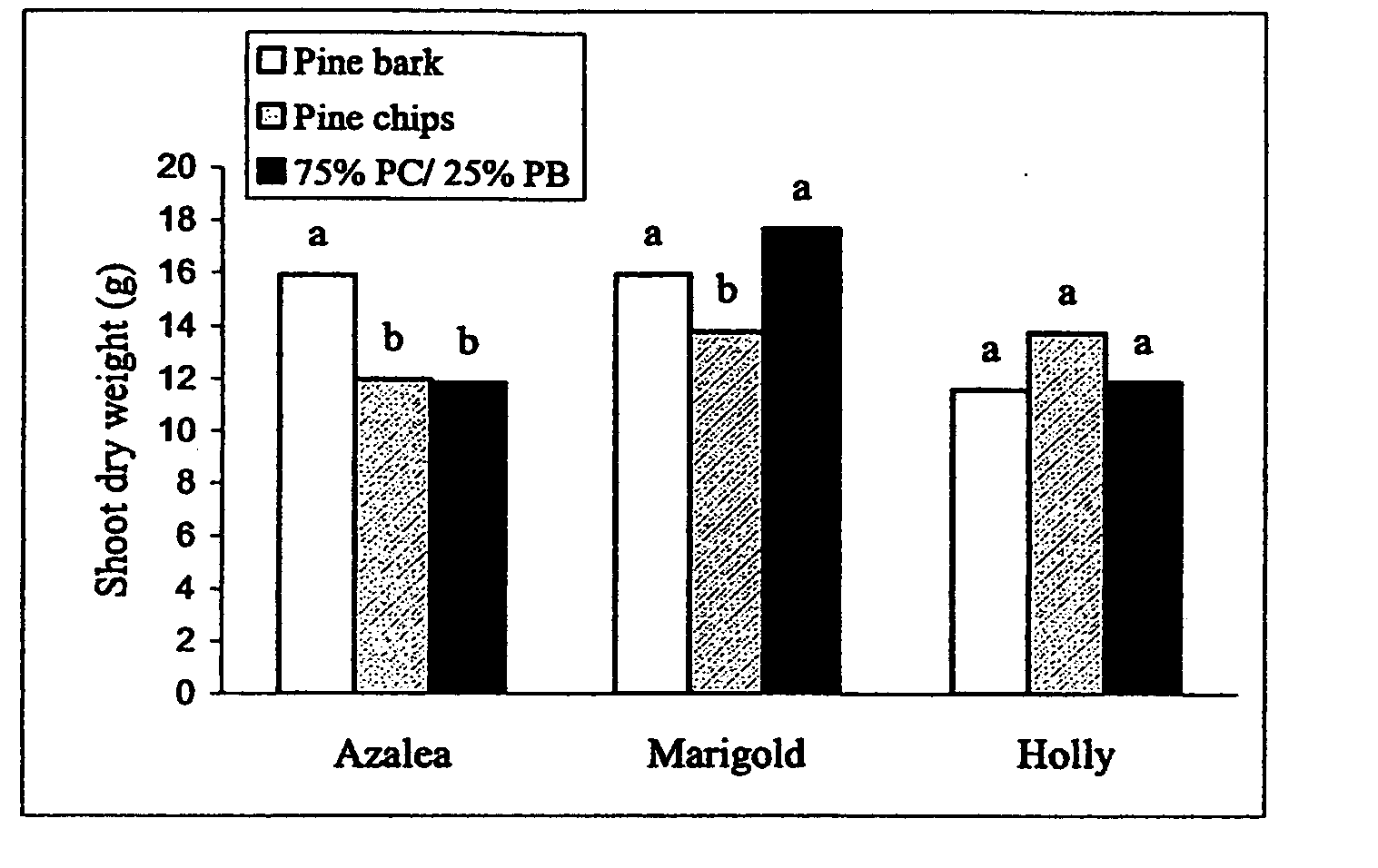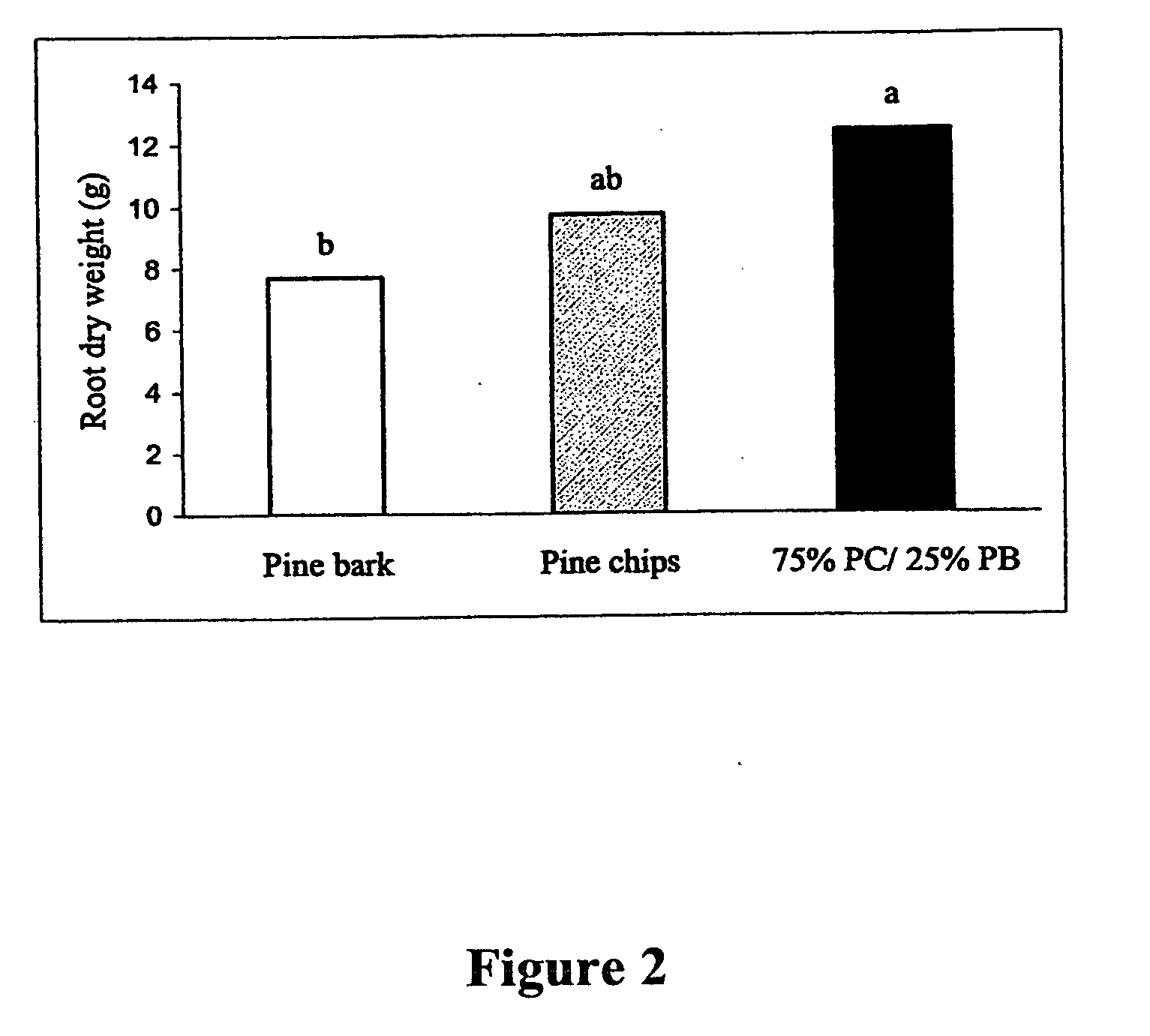Chipped wood as a substrate for plant growth
a plant growth and substrate technology, applied in the field of plants and substrates, can solve the problems of limiting the availability and use of plants, increasing the cost of mining and shipping, and unsure of their future availability and cos
- Summary
- Abstract
- Description
- Claims
- Application Information
AI Technical Summary
Benefits of technology
Problems solved by technology
Method used
Image
Examples
example 1
Preparation of a Substrate
[0080] Wood chips were produced by grinding a 17 m long by 25 cm basal diameter loblolly pine (Pinus taeda L.) log (including the bark) with a Morbark Chipper (Winn, Mich.) operated at Wood Preserver, Inc, Warsaw, Va. to create pine chips (PC). These types of chips are routinely produced by the forestry industry and used for paper manufacturing or as energy source at power plants. Chip size was reduced further with a Crary Bear Cat chipper (West Fargo, N. Dak.) to a particle size suitable for a container substrate (Table 3). Ground, aged loblolly pine bark (PB; a conventional PB substrate) was used as a second substrate and blended with PC for a third substrate.
TABLE 3Particle analysis of the three differentcontainer substrates used in this study.Particle size range(mm)Pine Bark (PB)Pine Chips (PC)75% PC / 25% PB>12.5 0.3z006.39.20.42.74.758.41.23.72.3628.8 56.049.522.81.31.51.49.69.48.90.7115.1 21.418.80.56.23.54.70.3555.12.23.10.254.01.52.30.1773.41.01.7...
example 2
Use of a Substrate to Grow Potted Plants
[0081] Due, at least in part, to uncertainties of future supplies of pine bark (PB) and peat moss, the suitability of ground Pinus taeda logs (pine chips or PC) as a substrate for growth of plants was tested. More specifically PC were compared to ground PB as a potential container substrate for Japanese holly (Ilex crenata Thunb.‘Chesapeake’), azalea (Rhododendron obtusum Planch. “Karen”), and marigold (Tagetes erecta Big. “Inca Gold”). The three plant species were potted in early spring in 2.8 liter plastic containers with the following substrates: 100% PB, 100% PC, and a mixture of 75% PC to 25% PB. Osmocote Plus (Grace-Sierra Horticulture Products, Marysville, Ohio) at 7.5 kg / m3 for holly and marigold and 5 kg / m3 for azalea were pre-plant incorporated into each substrate. Initially the substrate solution EC levels of the PC treatments were lower than PB, therefore PC treatments received occasional fertilizer applications in the irrigation ...
example 3
Use of a Substrate to Grow Poinsettias
[0094] The previous Example demonstrated that pine chips are an effective substrate for growing woody (azaleas and holly) or herbaceous plants (marigold). The following is a summary of experiments further investigating the effectiveness of pine chips as a container plant growing substrate. An experiment was conducted to determine if pine chips are an effective substrate for growing poinsettia, the most popular greenhouse potted plant in the U.S.
[0095] Eight rooted cuttings of poinsettia were potted in each of three substrates and grown about 3 and one-half months. The three substrates were as follows: commercial peat lite (peat lite is equivalent to a standard commercial mix used extensively in the greenhouse industry), pine chips produced with a knife ring flaker (see Table 2, second column, above). Plants were fertilized with a 20-10-20 fertilizer in the irrigation water at a rate of 200 ppm N as irrigation was needed. At the end of the expe...
PUM
 Login to View More
Login to View More Abstract
Description
Claims
Application Information
 Login to View More
Login to View More - R&D
- Intellectual Property
- Life Sciences
- Materials
- Tech Scout
- Unparalleled Data Quality
- Higher Quality Content
- 60% Fewer Hallucinations
Browse by: Latest US Patents, China's latest patents, Technical Efficacy Thesaurus, Application Domain, Technology Topic, Popular Technical Reports.
© 2025 PatSnap. All rights reserved.Legal|Privacy policy|Modern Slavery Act Transparency Statement|Sitemap|About US| Contact US: help@patsnap.com



